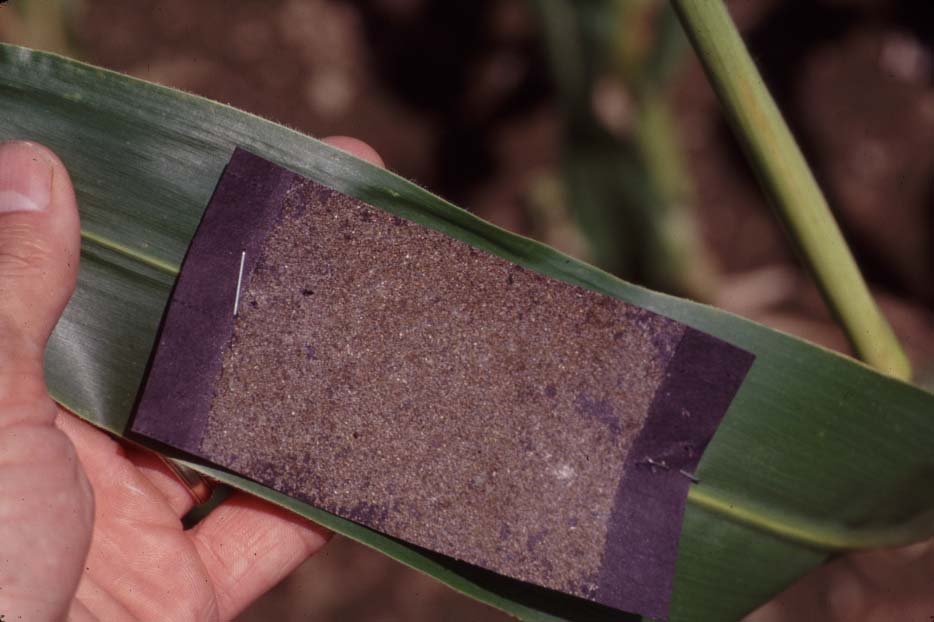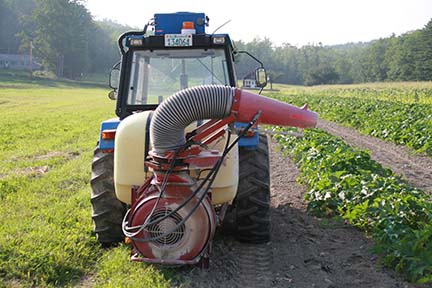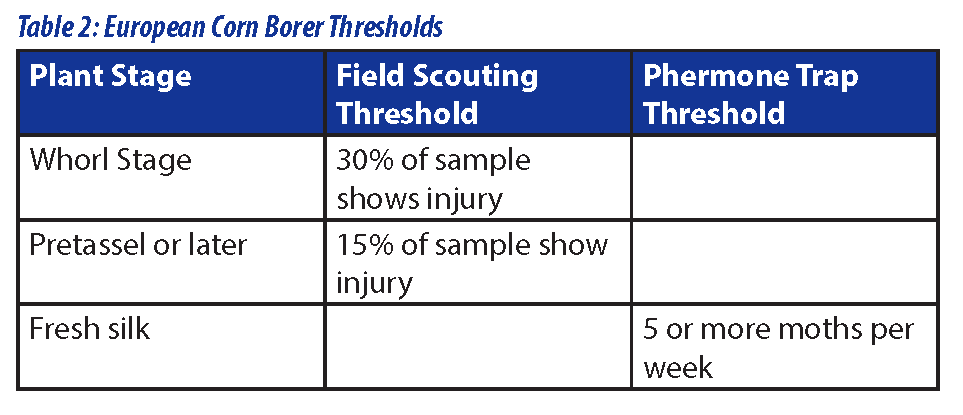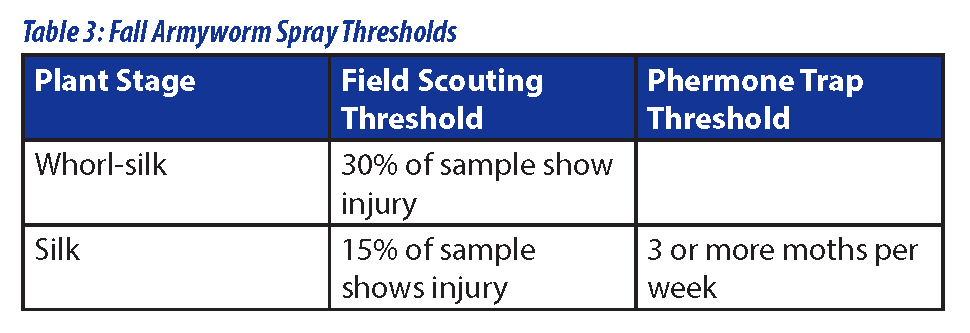Introduction
Integrated Pest Management (IPM) arose as an alternative to the conventional techniques growers were using to handle pest problems in the 1960’s and 1970’s. In New Hampshire sweet corn fields, “conventional techniques” usually were to apply chemical insecticides to the sweet corn, either on a calendar basis, or automatically based on growth stage. As concerns rose about environmental and off-target effects of insecticides, and increasing insecticide costs, UNH Cooperative Extension offered an alternative approach: IPM.
In this approach, we recommend that growers: 1) use preventative and/or suppressive measures against the pests; 2) monitor pest populations, to be aware of changes; 3) consider all the control options available, not just chemical sprays; and 4) when spraying is employed, base it on the vulnerability of the crop (growth stage) and the size of the pest population.
We have three major insect pests of sweet corn in New Hampshire: European corn borer (ECB), corn earworm (CEW), and fall armyworm (FAW). Occasionally we have problems with cutworms, common stalk borer, armyworm (that is a different species from fall armyworm), or sap beetles. These insects vary in numbers and timing. Growers who automatically apply insecticides without monitoring pest numbers end up:
1) spraying some times when there is no need
2) have other times when their spraying isn’t intense enough to control the pests.
By basing pesticide use on vulnerability and monitoring, spraying is done only when it is needed. This reduces:
1) growers’ spray bills;
2) the chance of getting caterpillar injury in the ears;
3) the risk of pests becoming resistant to pesticides;
4) killing beneficial organisms;
5) the risk of farm worker exposure to pesticides; and
6) possibility of negative environmental effects from pesticides.
European corn borer is the most predictable of the three major species. It has two generations per year here. In southern New Hampshire the two periods of moth flight are separated by 10 to 14 days (usually about July 15 to August 2) when very few or no ECB moths fly. Corn earworm and fall armyworm do not survive New England winters, and re-invade from the south each year. Frontal systems coming from the south frequently carry many thousands of CEW or FAW moths here. Overnight the numbers can drastically change, so monitoring is very helpful. Luckily, there are very effective traps available.
Preventation/Suppression
Destroying sweet corn crop residues shortly after harvest can significantly reduce pressure from European corn borer (ECB) the following year. ECB is the only one of the three major pests that successfully overwinters in New Hampshire. They spend winter as larvae, in the stalks.
Rotation and plant diversity play a role in managing these pests. Maintaining plant diversity in and around the fields (rotation is one method) allows for higher numbers of natural enemies to search your corn. The effect is minor, and we eliminate some of those natural enemies when we apply chemical insecticides to the fields. By reducing spraying, and switching to insecticides that are narrow-spectrum, we can preserve some of the natural enemies.
Row covers might be considered a preventative approach. Rotate your crops, and place the row cover shortly after crop emergence. You might even be able to keep it on until harvest, if you allow enough slack. We performed several experiments with this technique from 1988-1991. We used Sprite, the earliest variety available at the time. We left covers on until harvest and found the harvest was 10 days earlier, and yield was 21% higher than the same variety in the adjacent (not covered) rows. Only 3% of the ears showed European corn borer injury (no spraying). We saw little or no pollination problem, but logistics were challenging.

Other (non-pesticide) Control Measures
Introducing Parasites
You can purchase and release egg parasites to control ECB, and it may control other caterpillars too. The species is Trichogramma ostriniae. Trichogramma pretiosum may work almost as well. Basically, you arrange for shipments of the parasites to arrive, spanning the periods when ECB’s are flying. Depending on where you are, it may require 3 to 6 weeks of shipments. We tested this in Columbia, NH in 1996. It worked well, but was much more expensive than spraying. For growers without spray equipment, this may be an attractive option.
An unexpected problem was that ladybugs ate many of them! The parasites arrive inside eggs of meal moths, glued to cardboard. Shortly after we placed the cards in the field, ladybugs started eating the eggs (which contain the parasites). Two local suppliers for these parasites are IPM Laboratories in Locke, NY and The Green Spot in Nottingham, NH.

Using Genetically-Modified Sweet Corn as a Control Method
There are now several varieties of sweet corn that have been genetically modified in the laboratory to include genes from Bacillus thuringiensis (B.t. for short), a pathogen of caterpillars. These varieties presently control ECB well, but are less effective on CEW or FAW. The seed may be more expensive than other seed. The producer usually makes planting suggestions (like not growing all of your sweet corn in B.t. varieties) to avoid having a large percentage of the acreage in crops with B.t. genes. If you want to grow these varieties, you’ll have to sign an agreement with the company. Basically, the suggestions and agreement are designed to keep you from reproducing the seed, and delay or reduce the risk of caterpillars becoming resistant to this method. Once they become resistant to B.t., both the genetically modified varieties and the B.t. sprays (Dipel, Biobit, XenTari, etc) will be ineffective. There are some newer GM sweet corn varieties that have multiple B.t. genes, and improved effectiveness. The silk, foliage and most kernels (not all) express the B.t. proteins that are toxic to caterpillars. These varieties provide virtually 100% control of ECB (as do the current ones), and fairly good control of CEW. A few CEW larvae survive, so insecticide treatment when CEW moth flight is very high may be necessary. Fall armyworm damage is significantly reduced by these new varieties, but not completely controlled. These new varieties may appear on the market in 2012.
This might be an attractive option for growers who have limited ability (time, labor, equipment, access to field) to apply sprays. One major consideration should be your customers’ reaction to buying and eating a genetically modified crop. For certified organic growers, such crops are not allowed. Recent reduction in ECB problems in New York and New England may be in part caused by increasing acreage planted to GM field corn.
Biological and “Green” Insecticides
There are several products containing spores and protein crystals of Bacillus thuringiensis, that are registered for use on sweet corn caterpillars. For treating ECB in the whorl, some of these are extremely effective, and are virtually non-toxic to people. Trade names include Dipel, XenTari and others. They are not quite as effective at controlling caterpillars in the ears. For fall armyworm, it is more effective on the young larvae than the larger ones.
Soybean oil is sometimes used by organic growers for corn earworm control. Often it is mixed with B.t. and applied by hand to the fresh silks. Labor costs are high for this method, but it is approved for certified organic growers.
Sprayer Types and Effectiveness
Mist blowers are very fast at covering large sweet corn acreage, but research proves that they give poor results in controlling most sweet corn insects. They are great for getting light pesticide coverage over the exposed leaves and stalks. But in most cases, our target in spraying is to get thorough coverage, down the whorls or on the silks. If a mist blower is your only sprayer option, you can improve its effectiveness by: 1) applying high gallonage (60 to 100 gallons/acre); 2) place the spray head high, and aim somewhat downwards; 3) incorporate a drive row for the sprayer every 16 rows, and spray from both sides of the block, not just from one; 4) use a wetting agent; and 5) consider spraying early in the morning, after a heavy dew. The dew will help run spray droplets down into plant recesses. This is especially helpful for FAW control.
A high clearance boom sprayer is very effective for late whorl stage treatment. A high clearance boom with drop nozzles is effective for silking stage corn.

Pesticide labels, registration & availability change so rapidly, you should consult a recent publication (like the current New En gland Vegetable Management Guide) for options. Many CEW’s are now arriving in New Hampshire with resistance to pyrethroid insecticides, so these products may not be as effective as they were in 1999-2002.

Note: Thresholds apply only to corn in the fresh silk stage. If maximum daily temperature is less than 80 degrees F, lengthen the spray interval by one day.

Note: If silking corn is not being sprayed for other insects, spray once if five or more ECB moths are captured in one week.

Note: If ECB and FAW damage are found at the same time, add them together when calculating total % damage. Treatment of silking corn for ECB or FAW is generally not necessary if corn is being treated for corn earworm. If fresh silking corn is not being sprayed for insects, apply one spray if over 3 FAW moths are trapped in one week.
Monitoring Sweet Corn Pests
There are three major insect pests we monitor in sweet corn: corn earworm, fall armyworm, and European corn borer. The adults of all three pests are moths. Economic damage to corn is caused by the larvae (caterpillars or worms) of these moths. Due to differences in the larval feeding habits of each species, management decisions are based on different monitoring techniques. Feeding damage from corn earworm usually remains hidden within the ear. For this reason, we determine the need for CEW controls using the average number of moths caught in pheromone traps. In contrast, damage from FAW and ECB is readily visible on corn leaves and stalks. Pheromone traps for these two pests alert us to the presence of adult moths and signal the need for field scouting. You can monitor their field density, and make accurate pest management decisions by learning to identify FAW and ECB feeding.
FAW moths migrate from the south each year, usually arriving in late July or August. The larvae are voracious feeders. FAW feeding damage is large, ragged holes in leaves, and sawdust-like excrement. Large populations may kill or stunt young corn plants. ECB overwinters in New England and completes two generations each year throughout most of New Hampshire. The first generation occurs from early June to early July. The second occurs from mid July to September. Corn plants are damaged by larvae feeding on developing leaves in the whorl. When these leaves unroll, the characteristic ‘shot hole’ injury is seen. Corn borer larvae also tunnel into the tassel as it grows out of the whorl resulting in holes in the stalk with dried pale powdery excrement and broken tassels. Larvae of fall armyworm and corn borer may also invade the ear itself.
Field Scouting for Sweet Corn Pests
Damage from ECB (and FAW) is easy to detect in the late whorl stage, when there is still time for effective treatment with insecticides. By learning to identify the feeding damage, you can monitor their field density, and make accurate pest management decisions. Scouting is easy and takes only a few minutes.
Early season: Wait until the late whorl stage to scout. This is before the tassel grows out of the whorl. Select at least 5 sites across the planting, all of the same variety and planting date. Avoid sampling at the edge of the field. To make your sampling most representative of the field, follow a rough X pattern across the planting. At each site, examine 20 stalks, and look at the whorl area for the tiny “shot holes” [see photo on page 2] that show corn borers are in that stalk. Often there is a tiny bit of light, powdery frass adjacent to the small holes. If you see such signs, mark that stalk as infested. As you move across the planting, keep track (pocket pad is helpful) of two things: 1) how many stalks are infested; and 2) the total number of stalks you’ve counted. Stop at 100. The threshold is: if 30 or more of the stalks are infested, it is worthwhile to treat with an insecticide. For very early corn (high value), you may wish to adjust that threshold downwards to 15. If the infestation rate is below threshold, it will cost more to treat the corn than the damage is worth. For sweet corn in the pre-tassel stage (tassel is visible in the whorl), use the 15% threshold.
Later season: we follow the same procedure, scouting in late whorl or pre-tassel stage, but expect that fall armyworm damage may appear as well. Fall armyworm moths migrate from the south each year, usually arriving in late July or August. The larvae are voracious feeders. Larvae chew large, ragged holes in leaves, and leave lots of coarse, messy droppings. They prefer the youngest stage corn that is available. If no young corn is available, they attack silks, husks and ears, leaving the same large, ragged holes and messy droppings. We increase our monitoring for FAW damage if pheromone traps show recent adult moth captures.
Additional Resources
Identifying Common Sweet Corn Caterpillars
Setting Up Traps to Monitor Sweet Corn Insects
Identifying Moths in Traps for Sweet Corn Pests
Suppliers
Gempler’s. 800-382-8473. This supplier has both types of traps, the fumigant strips, and the Scentry ECB lures, but not the other lures.
Great Lakes IPM. 800-235-0285. This supplier has both types of traps, all of the lures we recommend, and fumigant strips.
IPM Laboratories, Locke, NY. 315-497-2063. This supplier has parasites and predators, related supplies, and references.
This publication was supported in part by IPM grants from the New Hampshire Department of Agriculture, Markets and Food, and the National Institute for Food and Agriculture, United States Department of Agriculture.
Photo credits: all photographs are by Alan T. Eaton.
Acknowledgements: Thank you to Suzanne Hebert for layout and posting of this publication.
Additional Information
University of Maine Sweet Corn IPM fact sheet by Jim Dill & David Handley.
Download the Resource for the complete fact sheet and a printable version.

